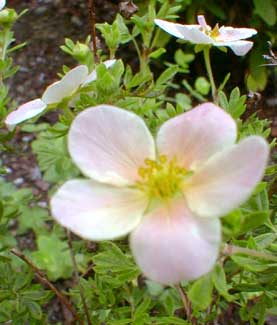
'Pink Whisper'
Shrubby Cinquefoil
"The fields having been
Picked clean, the sheaves
Bound evenly & piled at the roadside
Among cinquefoil, as the toothed moon rises."
-Louise Gluck
(b.1943)
(b.1943)
Pink-flowering shrubby cinquefoil was formerly a non-existent color, but there are now a small handful of pink cultivars developed since the 1990s. 'Pink Whisper' has one-inch flowers of bright peach & salmon-pink over mid-green to bluish-green foliage so fine-textured it almost looks like some kind of fuzzy mattress stuffing.
Called cinquefoil because so many species of potentilla have palmate leaves & look very much five-fingered, though the shrubby cinquefoil does not have this type of leaf, being very fine-foliaged. Upon closest inspection it does have three to seven leaflets to every leaf.
It is in full flower by June & reblooms right into autumn. 'Pink Whisper' has slightly smaller flowers than on average for the species, but they nevertheless make a great showing. If summer nights are warm, the flower color may not persist well, but if they do fade to yellow they'll still be pretty.
Growth habit can vary a great deal depending on its conditions, & especially upon its age since its growth rate is rather slow. It can be anywhere from one foot tall to four feet tall, typically wider than it is high. On average a mature specimen will be two or three feet high & wide, & to let it get larger only encourages legginess or untidiness.
It will need late-winter or early spring sheering to remain compact. If it gets untidy, scruffy, or dead-looking at the center, it can be cut to the ground to start over fresh & revitalized; this will probably be necessary every third or fourth year, but by no means every year. It is almost never bothered by pests or diseases though spider mites can be occasional problems, which can again call for sheering to the ground, burning the infested branches.
Once established it is relatively drought hardy but can be sensitive to droughtiness at first. It wants full sun to flower well in our area, but in hotter zones will need bright shade & persistent moisture. It is not fussy about soil pH. It is extremely cold-hardy but not as heat-hardy unless after a hot day the nights cool down a great deal. Potentilla usually bounces back from transplant shock but will be sensitive until re-established.
As a wild shrub P. fruticosa is native to moderately high elevations throughout the northern hemisphere, circumpolar in its distribution, including here in the Pacific Northwest in the Olympic & Cascade mountain ranges. With such a broad distribution, it has many forms or variants that have been valuable in breeding programs for the sake of increasing numbers of colorful garden cultivars.
It is extremely cold-hardy & can be grown in USDA zones 3 through 7, & in Pacific Northwest Zone 8, & with mulching to protect roots in winter, even in Zone 2. It will not fair well in warmer climates, which might include the east coast Zone 8, though it is worth trying with some protection in summer.